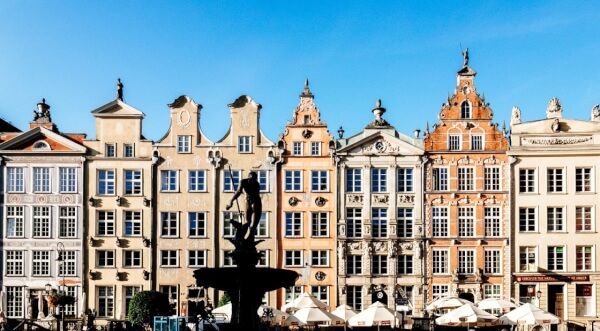How to retire to Poland: a complete guide
Whether you’re a Brit, Australian, or an American, Poland might not be the first retirement destination that comes to mind. But the eastern European country...

Almost 90% of Polish people identify as Roman Catholics, so Christmas is an especially important time in Poland. Although it's a naturally fun time for people to celebrate and connect with family and friends, the religious significance of Christmas is also observed through attending mass and fasting during Advent. If you’re in Poland over the Christmas season, you’ll find there’s a mix of customs, some of which have been established in Poland for generations, and others which are somewhat newer.
Here’s everything you need to know about Christmas in Poland.
Advent, which starts on December 1st, is the beginning of the Christmas season in Poland. Traditionally, Advent is the time for getting practically and spiritually ready for Christmas, which is one of the most important dates in the Christian calendar. That means the house would be fully cleaned and decorated, and people would choose to avoid excess to spiritually prepare for the big day. Obviously not all families do the same. There’s still much of Polish Christmas that’s more about the religious significance than the commercial aspects.
Advent would traditionally be a time for reflection and to renew your faith, which is why Polish people would go to church more often, and choose to fast or avoid some luxury foods as an act of spiritual devotion. There would be practical preparation to do as well, such as cleaning the house and washing windows. As with many other places in the world, adherence to these religious traditions is decreasing, but they certainly set the tone for the Christmas customs in Poland.
During Advent, kids take part in Jasełka (nativity plays) in their schools, with parents going along to watch. People also take clementines to share with their friends or work colleagues, as these are traditionally associated with getting ready for Christmas.
Families put up Christmas trees at home and decorate them with ornaments, which are often very intricate and can be made in the shape of people, like small dolls. The tree would have traditionally been brought into the home on Christmas Eve, but many people choose to do so earlier as trees arrive in stores and shopping centres long before then.
Christmas Eve is a bigger day than Christmas Day in many ways, despite being a normal working day for many people. There’s a traditional feast eaten after sunset followed by attending church. Kids are usually allowed to open their gifts after dinner.
One fun thing people tend to do over Christmas is watch specific films.The 1990s blockbuster Home Alone is the most popular by far, and always shown on or around Christmas Eve. However, other films such as Die Hard and Speed are also commonly on local tv stations.
*Pierogi (*Polish dumplings) are a very common food throughout the festive season. You’ll see them stuffed with different things including vegetables and cheese. They’re often served with sour cream and onions.
Christmas Eve would have traditionally been an important religious day where people would be getting ready for the arrival of Jesus. That means that people would either avoid eating altogether, or at least limit the food they eat until sunset. The biggest feast of the season is eaten on Christmas Eve, before or after mass for those who choose to go.
The meal opens with the breaking of bread - usually a large wafer, much like the one used in church ceremonies for communion. The table is laid with an extra place, because guests will always be welcomed. Bread is passed around and shared with everyone there, including the family pets. This is a very old tradition from feudal times that used to involve the local landowners and gentry inviting in their servants and staff to share bread and be united.
There are usually a selection of 12 dishes, which are largely vegetarian. Having 12 dishes is significant, because it represents the 12 disciples, and are also said to guarantee luck for each of the next 12 months. Beetroot soup is a common dish to open the meal, with hot dishes such as sauerkraut and Pierogi. Often carp or pike is eaten as part of this feast, as this is also considered a lucky food. The food will include an eclectic mix of ingredients, as it’s supposed to show something of the range of crops that God has given man - so you’ll find mushrooms to represent food from the forest, root vegetables for field crops, fruit from the orchard, and so on.
In lots of places in Poland, gifts are brought by Święty Mikołaj (Saint Nicholas). However, there are slightly different traditions in different parts of the country, with Dziadek Mróz (Grandfather Frost) also making an appearance. Grandfather Frost is a kind of Slavic Santa, but he’s traditionally shown wearing a blue coat rather than red.
According to the ING International Christmas Survey, 52% of Polish people get practical presents at Christmas time. It’s pretty unusual to give cash instead of a gift, although 26% of those surveyed said that they got gift cards or money for Christmas.
According to survey data, Polish people spend a median amount of €70 each over the Christmas holiday. That’s significantly less than the British who topped the list with an average of €420.
When asked if they think Christmas is too commercial, 53% of Polish people answered yes. This is the lowest percentage of any of the nationalities covered by the survey and significantly below the average which stood at 70%.
Christmas in Poland remains far more a time of traditions and celebrating with friends and family, rather than excessive gift-giving. However, the season is inevitably expensive because of travelling to see family and friends, and buying food and drinks.
If you’re in Poland for Christmas, you might find you need to move your money around between accounts held in different countries to help finance gifting and travel. As many expats and frequent travellers know, you can end up paying high fees for international transfers if you go through your regular bank. Even though some services advertise their international money transfers as free or cheap, they’re often not. The costs - and the profit for the bank - is simply hidden within a poor exchange rate.
You can avoid this and get your international transfer for less if you use a specialist service like Wise. Wise moves your money quickly and efficiently, and what’s more, they use the real exchange rate. The rate you'd find on Google, with no sneaky extra charges. You only pay a small fixed fee, clearly shown upfront to make sure there are no surprises.
You might also want to open up a Wise borderless multi-currency account which lets you hold money in several different currencies, including Polish złoty. This is especially handy for travellers and expats, as you can see your balance across different currencies in one place and switch between them at a low fee when you want to.
See for yourself if you can get a better deal with Wise.
In Poland, the party really starts to get going in December with the start of advent. People count down the days attending nativity plays, cleaning and decorating their houses in preparation for the big day.
Important festive dates for Poland:
| Polish Christmas Holidays | Date |
|---|---|
| Wigilia (Christmas Eve) | 24th December |
| Pierwszy Dzień Bożego Narodzenia, Drugi Dzień Bożego Narodzenia(the 1st and 2nd days of Christmas) | 25th and 26th December (Public Holiday) |
| Sylwester (New Year’s Eve) | 31st December |
| *Nowy Rok (*New Year’s Day) | 1st January (Public Holiday) |
| Objawienie Pańskie (Epiphany) | 6th January (Public Holiday) |
If you’re in Poland over the advent and Christmas period as a visitor or if you live there as an expat, you’ll find lots of great traditions which will make sure your experience is memorable. Because Christmas is a time when nobody should be alone or hungry, you might even be invited to join another family and enjoy a real Polish Christmas at home. Wish your friends and neighbours ‘Wesołych Świąt!’ and you'll be made very welcome.
*Please see terms of use and product availability for your region or visit Wise fees and pricing for the most up to date pricing and fee information.
This publication is provided for general information purposes and does not constitute legal, tax or other professional advice from Wise Payments Limited or its subsidiaries and its affiliates, and it is not intended as a substitute for obtaining advice from a financial advisor or any other professional.
We make no representations, warranties or guarantees, whether expressed or implied, that the content in the publication is accurate, complete or up to date.

Whether you’re a Brit, Australian, or an American, Poland might not be the first retirement destination that comes to mind. But the eastern European country...

Often overlooked thanks to its close proximity to more glamorized European countries, those who live in Poland can sometimes feel like they’ve stumbled on the...